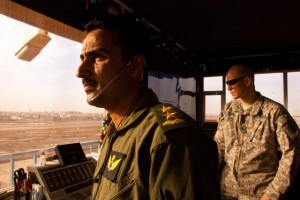Special to WorldTribune.com
BAGHDAD — The Iraq Air Force has begun operating an advanced air
traffic control facility at the Imam Ali Air Base near Basra. The $55 million facility, supplied by Lockheed
Martin, was designed to integrate air traffic control radars throughout Iraq.

Officials acknowledged that the U.S. military as well as L-M would find it difficult to help Iraq operate the air traffic control facility. They cited the arrest of hundreds of U.S. and other foreign contractors since the American military withdrawal a month ago.
“While private organizations are often able to resolve low-level
disputes and irregularities, this issue is beyond our ability to resolve,” the Washington-based International Stability Operations Association, which represents several companies in Iraq, said in a Jan. 15 letter to Secretary of State Hillary Clinton.
“Since early September [2011], we have been conducting training on this system to the Iraqis,” L-M technical director Scott Hosking said. “A little bit more hands on, and a little bit more one-on-one type interaction has brought them a long ways, and I think they will be very proficient and should be able to step right into the role.”
The U.S. military withdrew from Imam Ali in December. The air
traffic control facility, a project launched in 2009, was constructed by the
U.S. Army Corps of Engineers and designed to monitor all of Iraq’s air
space.
“Now that the radar is up and running, they are able to use the
computers to do their aerodefense mission,” Tech. Sgt. Denise Wright said
before the U.S. withdrawal was completed on Dec. 15. “Because of the
communications capability that is set up, Baghdad is also able to receive
transmissions of what they are seeing here.”
The final stage of the project focused on training and initial
operations. Officials said the Iraqi personnel were instructed in radar
technology as well as communications terminology.
“They will have their own network, as we are familiar with the
terminology of DSN, Defense Switch Network,” Ms. Wright said. “They have the
IDN, Iraqi Defense Network. They can work together with Baghdad. They are
able to communicate with each other.”
As with other training, language was deemed the greatest barrier.
Officials said the U.S. military used interpreters as well as Iraqi officer
who spoke English to help in classroom and on-site instruction.
“The language barrier — that was our biggest hurdle,” Master Sgt.
Marcus Williams, a U.S. military adviser, recalled. “At the beginning it was
rough, but the difficulties we were able to overcome.”

You must be logged in to post a comment Login